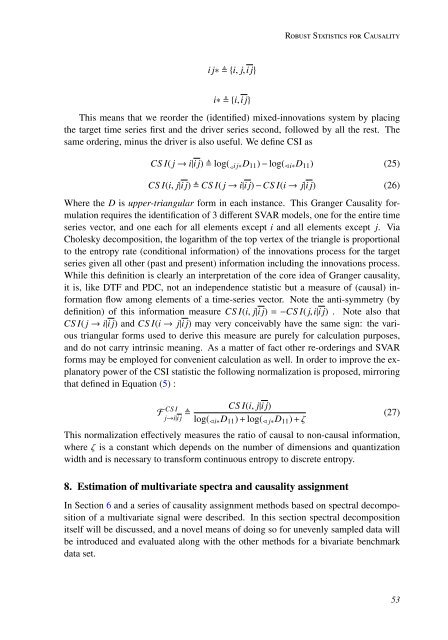Causality in Time Series - ClopiNet
Causality in Time Series - ClopiNet
Causality in Time Series - ClopiNet
Create successful ePaper yourself
Turn your PDF publications into a flip-book with our unique Google optimized e-Paper software.
Robust Statistics for <strong>Causality</strong>i j* {i, j,i j}i* {i,i j}This means that we reorder the (identified) mixed-<strong>in</strong>novations system by plac<strong>in</strong>gthe target time series first and the driver series second, followed by all the rest. Thesame order<strong>in</strong>g, m<strong>in</strong>us the driver is also useful. We def<strong>in</strong>e CSI asCS I( j → i|i j) log( ⊳ i j*D 11 ) − log( ⊳i* D 11 ) (25)CS I(i, j|i j) CS I( j → i|i j) −CS I(i → j|i j) (26)Where the D is upper-triangular form <strong>in</strong> each <strong>in</strong>stance. This Granger <strong>Causality</strong> formulationrequires the identification of 3 different SVAR models, one for the entire timeseries vector, and one each for all elements except i and all elements except j. ViaCholesky decomposition, the logarithm of the top vertex of the triangle is proportionalto the entropy rate (conditional <strong>in</strong>formation) of the <strong>in</strong>novations process for the targetseries given all other (past and present) <strong>in</strong>formation <strong>in</strong>clud<strong>in</strong>g the <strong>in</strong>novations process.While this def<strong>in</strong>ition is clearly an <strong>in</strong>terpretation of the core idea of Granger causality,it is, like DTF and PDC, not an <strong>in</strong>dependence statistic but a measure of (causal) <strong>in</strong>formationflow among elements of a time-series vector. Note the anti-symmetry (bydef<strong>in</strong>ition) of this <strong>in</strong>formation measure CS I(i, j|i j) = −CS I( j,i|i j) . Note also thatCS I( j → i|i j) and CS I(i → j|i j) may very conceivably have the same sign: the varioustriangular forms used to derive this measure are purely for calculation purposes,and do not carry <strong>in</strong>tr<strong>in</strong>sic mean<strong>in</strong>g. As a matter of fact other re-order<strong>in</strong>gs and SVARforms may be employed for convenient calculation as well. In order to improve the explanatorypower of the CSI statistic the follow<strong>in</strong>g normalization is proposed, mirror<strong>in</strong>gthat def<strong>in</strong>ed <strong>in</strong> Equation (5) :F CS Ij→i|i j CS I(i, j|i j)log( ⊳i* D 11 ) + log( ⊳ j* D 11 ) + ζThis normalization effectively measures the ratio of causal to non-causal <strong>in</strong>formation,where ζ is a constant which depends on the number of dimensions and quantizationwidth and is necessary to transform cont<strong>in</strong>uous entropy to discrete entropy.8. Estimation of multivariate spectra and causality assignmentIn Section 6 and a series of causality assignment methods based on spectral decompositionof a multivariate signal were described. In this section spectral decompositionitself will be discussed, and a novel means of do<strong>in</strong>g so for unevenly sampled data willbe <strong>in</strong>troduced and evaluated along with the other methods for a bivariate benchmarkdata set.(27)53





